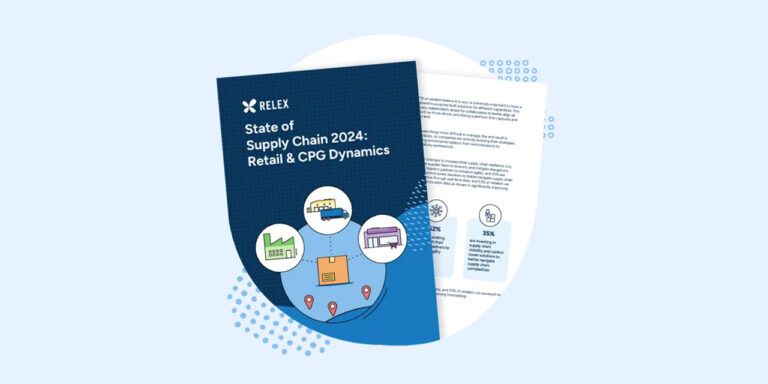There’s a famous Roman maxim; festina lente; make haste slowly. What it means is that if you do things properly then speed and quality do not have to be mutually exclusive. Doing things quickly does not have to mean rushing. Think ‘quick and dirty’ except without the dirty bit! You can remain committed to a process, focus only on issues that matter and be rigorous and still move forward purposefully and with speed. Large scale forecasting and replenishment implementations are generally treated as major IT projects. But they should NOT be seen primarily as IT projects.
Forecasting and replenishment implementations are, above all, about adapting and improving processes and operations models. Unfortunately implementations tend to get labelled as IT projects whenever they involve software.
In this white paper we will take an overview of the building blocks of successful forecasting and replenishment implementations for fresh goods. We find that successful projects generally follow the same path, and master each of the following steps:
- Get your top management committed
- Create and communicate clear goals
- Design business processes and technology together
- Move quickly to live testing
- Measure and adjust
- Roll out when satisfied
Commit Top Management
Developing the replenishment of fresh goods can have a huge impact on any business of which they form a significant part. Simply by reducing spoilage, let alone accounting for any of the other benefits, it’s possible to add tens of percentage points to the profits generated by short-shelf-life items. Moreover the entire cost of the development initiative can often be offset by the labour cost-savings made by cutting routine ordering control. The big potential payoff however comes with an equally big risk. If not done properly, error-ridden forecasts or order parameters can have a significant negative impact on a business.
In our experience if an implementation is to be fast and straightforward the top management has to be in agreement about the goals of, and the risks associated with, the initiative. It’s generally easiest to get the necessary commitment when the projected impact of the development initiative is calculated and presented in plain financial terms. When people are persuaded of what it’s going to mean in pounds, shillings and pence then they get onboard.
Create and Prioritise Project KPIs and Communicate Them Widely
Companies will typically see improvements in several key metrics as a result of replenishment automation initiatives: Shelf availability is increased, spoilage is reduced, and supply chain costs are decreased. However, once the basic process is in order, further optimization often requires prioritizing certain result metrics over others. Multi-variable optimisation is only really possible if the team is clear about the acceptable minimum for each metric and the goals of and priority levels for all the metrics in play.
The thing about automatic replenishment is that central decision making becomes a reality for all the outlets under its direction. In practice it means that the process has to be led and choices on which goals to work towards have to be made.
In any implementation everyone involved should know the most important KPIs, their goal levels and priority. When it comes to trying the process in practice you can bet that everyone will have an opinion. Knowing what matters most in terms of KPIs and being able to weight them appropriately is key to being able to keep a sense of how the overall project is going and in turn to know where to deploy extra effort to produce further improvements.
Design Business Process and Technology Together
Regardless of the scope of the implementation we typically define the business processes and the IT processes in four workshops: 1) basic lifecycle replenishment, 2) promotion and sales event management, 3) seasons management, 4) assortment change and lifecycle management.
In the workshops we sit down with the client and establish who is responsible for what in any given situation, what kind of data is used and needed, and what system functionality and user interfaces are used. It’s important that we, as the solution provider, and the client design them together so, for example, if data from past promotions is inadequate or absent we will put our heads together to think of an another way to run the process until a proper data history is available.
The workshops are based on sector specific templates of use process and user interfaces. Most of the system design and configuration is actually done at the workshop stage; after the workshops the solution is ready to be tested live to see how the processes we defined and designed together work in practice.
Test in Real Life
There’s nothing like running a process in real life to find out how it actually works and where it needs fine tuning to achieve even better results. The Wright brothers didn’t spend years drawing up blueprints for airplanes; they tried stuff out to see what would work and what wouldn’t and made improvements on the basis of those results.
We have found that the most effective route forward is quick, real-life implementation with a scope that does not incur severe business risk. Normally we want the test to encompass all the possible logical and data complexities that we are likely to encounter, but be restricted in organizational and business scope to limit risk and change management issues. In retail we find the best option is to select a subset of stores that between them carry the whole assortment – that could mean anything from a handful to several dozen stores depending on the size of the client chain. In wholesale we find the best approach is to pick a number of individual buyers from within the team who between them cover a wide and varied range of products and then run the test on all those products.
In live testing the impact you are having on business results within the sample quickly becomes apparent as do the issues you have to tackle. Then it’s time to track progress and update your controls.
Measure and Adjust
When you have your live sample up and running on the system it’s time to move the implementation forward in earnest. Progress should be based on constant monitoring of performance against defined goals. There is always some aspect of the system to improve, and products that could be better optimized. The development cycle is normally:
- Track progress in overview using key metrics
- Drill down to exceptions to find opportunities for improvement
- Analyse how to develop
- Implement solution
- Observe results
The key thing is that the length of the development cycles should be measured in hours or days with the solution being fine tuned quickly to give the best results. At this stage we generally encourage teams to implement development ideas quickly as the downside risk is contained. Not only are you working on a limited part of the whole operation – in effect a live sandpit – but you also have the option of rapidly rolling back any changes you make that don’t work as you want.
Roll-out Quickly When You’re Ready
We’ve found that the roll-out goes far more quickly and smoothly when your test-bed implementation allows you to:
- Make a compelling case for real life benefits that you can sell quickly to all parties – They will ask “Why are we doing this?” and you can substantiate your answers
- Give a clear and specific description of how the process will work in practice with peers and colleagues taking explaining and teaching roles
- Deploy those with hands on experience to show colleagues how it’s done
As a rule faster roll-outs seem to go better than slower ones. It’s about momentum. Where possible, use the fact that everything works well in live operations to build confidence and to construct and resource an ambitious roll-out plan. Some of our customers have shown just how fast it’s possible to do this – one RELEX client rolled out the system to cover their whole assortment across 670 stores in just 1 ½ months. The longer the roll-out is the longer you have to deal with the complications of running two different processes – for instance your RELEX system and its predecessor. And the faster you roll-out the faster you get to the point where you save money. A good number of our clients have achieved a full ROI inside three months.
The Basic Pieces Needed
The basic elements you need in place before you can proceed with the implementation model we’ve outlined here are:
- A good understanding of your fresh supply chain process and its dynamics. There is nothing to be gained by proceeding if you don’t have a clear view of how the process is going and what the current challenges are.
- Having a partner who:
- Knows how it is done
- Brings expertise, insight and understanding to support you through the process
- Helps you circumvent the usual IT difficulties
- Enables on-the-fly testing and development
Case JJ Food Service: Implement Fast, Implement Fearlessly
JJ Food Service is a bulk supplier of goods to institutional caterers, restaurants and the public, headquartered on the North Eastern outskirts of London. The company has eight depots nationwide in the UK, a fleet of 200 temperature controlled vehicles, 8000 employees and a turnover of just under £200M p.a.
Top management committed: JJ Food has long seen itself as an early adopter of the best technology and actively seeks out options that will give it a competitive edge over others in its sector. The decision to work with RELEX was endorsed by all the company’s senior managers and COO Mushtaque Ahmed not only took personal charge of the implementation but acted as cheerleader-in-chief. “The first, critical achievement was that the whole team was wholeheartedly for using the system” says Mr. Ahmed. “They found the system very effective yet simple to use – training only took about 30 minutes.”
Create and communicate clear goals: The goals were clearly defined from the outset. The main targets were to reduce inventory levels and the amount of time that the small buying team was devoting to routine and repetitive tasks. Additional goals were to better match availability of seasonal goods to demand and to address the issue of spoilage with fresh goods.
Design business processes and technology together: Though JJ Food Service runs a fairly large buying and distribution operation its core team is quite small. There are a dozen buyers, all part of a team at head office, and so it was relatively straight forward to communicate with everyone who would be involved either in the design process or as an end user.
The design process was a close collaboration between senior members of the JJ Food Service team and RELEX. “The data analysis phase highlighted a lot of the anomalies and the inefficiencies in our operations,” says Mr. Ahmed.
For instance it became apparent that there were problems with a number of the slow moving lines JJ Food stocked; buyers had a tendency to overlook them because their focus was on high-volume, core product lines. It also became clear that the company’s master data needed to be better. Any system is only as good as the data it uses so improving the quality of data in the system became a priority.
At RELEX we generally find that design and implementation is a fluid and organic process where processes and systems prompt changes in one another. The system has to fit round a business’s operation, at the same time the rigours of designing and implementing a system inevitably make managers question whether the processes they use couldn’t also be improved.
Move quickly to live testing: The project moved quickly. The original deal was signed in April 2013 and the analysis work was carried out in May and June. At the beginning of July three buyers from the team of twelve and the products they handle were selected to be the focus of the design and live testing phase scheduled to last three months.
Measure and adjust: Making adjustments was a constant and fluid process, however the JJ Food Service team reacted quickly to each and every situation; close monitoring of KPIs and making the changes those prompted simply became a routine part of the development process.
Roll out when satisfied: Full roll-out was scheduled to begin in Q4 2013 but after just 10-11 weeks all the company’s buyers and all the products and suppliers they handled had already been pulled onto the system before the roll out was even due.”




